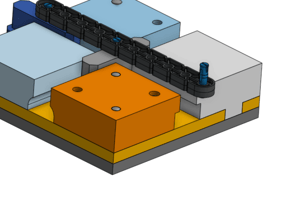Podcast
Questions and Answers
What behavior do female rats display to indicate they are receptive to mating?
What behavior do female rats display to indicate they are receptive to mating?
- Singing
- Nesting
- Ear-wiggling (correct)
- Ejaculation
What is necessary for the brain to release hormones that support pregnancy in rats?
What is necessary for the brain to release hormones that support pregnancy in rats?
- External fertilization
- Quitting copulatory behavior
- Single intromission
- Multiple intromissions (correct)
What does the Coolidge effect describe?
What does the Coolidge effect describe?
- Increased parental behavior after mating
- Variations in postcopulatory behavior
- The faster resumption of mating with a different partner (correct)
- The quick resumption of mating with the same partner
What is a characteristic of the copulatory lock observed in some species?
What is a characteristic of the copulatory lock observed in some species?
Where does internal fertilization take place?
Where does internal fertilization take place?
What behavior might occur after copulation in various species?
What behavior might occur after copulation in various species?
What behavior do male rats exhibit as part of their mating ritual?
What behavior do male rats exhibit as part of their mating ritual?
What was the primary belief of Dr. John Money regarding gender identity?
What was the primary belief of Dr. John Money regarding gender identity?
What is required for the masculinization of external genitals?
What is required for the masculinization of external genitals?
What significant event affected Bruce Reimer's early life?
What significant event affected Bruce Reimer's early life?
What was one outcome of the Reimer case on the scientific community's perspective?
What was one outcome of the Reimer case on the scientific community's perspective?
What happens in the absence of 5-alpha reductase?
What happens in the absence of 5-alpha reductase?
Which of the following describes appetitive behaviors in reproductive behavior?
Which of the following describes appetitive behaviors in reproductive behavior?
What condition was discovered in Caster Semenya?
What condition was discovered in Caster Semenya?
Which stage of reproductive behavior follows sexual attraction?
Which stage of reproductive behavior follows sexual attraction?
What notable characteristic did Caster Semenya possess regarding her chromosomes?
What notable characteristic did Caster Semenya possess regarding her chromosomes?
How did Brenda Reimer's experience reflect on her social treatment during childhood?
How did Brenda Reimer's experience reflect on her social treatment during childhood?
What factor aids in sexual attraction among species?
What factor aids in sexual attraction among species?
Which of the following statements best encapsulates the complexity of sex and gender?
Which of the following statements best encapsulates the complexity of sex and gender?
What action did David Reimer take at age 14 that marked a significant shift in his gender identity?
What action did David Reimer take at age 14 that marked a significant shift in his gender identity?
Which factor is crucial but not entirely determinative of gender identity, according to recent perspectives?
Which factor is crucial but not entirely determinative of gender identity, according to recent perspectives?
Why is there significant reluctance to study the biological aspects of sex and gender?
Why is there significant reluctance to study the biological aspects of sex and gender?
What role do pheromones primarily play in reproductive behavior?
What role do pheromones primarily play in reproductive behavior?
What is the effect of castration on a male rat?
What is the effect of castration on a male rat?
What is the significance of estrogen in female rats?
What is the significance of estrogen in female rats?
How does the amount of testosterone influence the copulatory score in guinea pigs?
How does the amount of testosterone influence the copulatory score in guinea pigs?
What role does progesterone play in the reproductive behavior of female rats?
What role does progesterone play in the reproductive behavior of female rats?
What is the function of the ventromedial hypothalamus (VMH) in female rats?
What is the function of the ventromedial hypothalamus (VMH) in female rats?
Which hormone is essential in making a female rat proceptive and receptive when ovaries are absent?
Which hormone is essential in making a female rat proceptive and receptive when ovaries are absent?
What happens to the dendritic trees of neurons in the VMH when estrogen levels increase?
What happens to the dendritic trees of neurons in the VMH when estrogen levels increase?
How does the VMH communicate with other areas of the brain related to reproductive behavior?
How does the VMH communicate with other areas of the brain related to reproductive behavior?
What role does the medial preoptic area (mPOA) play in male rats?
What role does the medial preoptic area (mPOA) play in male rats?
How does the paragigantocellular nucleus (PGN) influence male erection responses?
How does the paragigantocellular nucleus (PGN) influence male erection responses?
Which structure detects pheromones that activate male arousal?
Which structure detects pheromones that activate male arousal?
What is a characteristic difference in sexual response between men and women?
What is a characteristic difference in sexual response between men and women?
Which phase involves increased blood flow to the vagina and production of lubricating fluid?
Which phase involves increased blood flow to the vagina and production of lubricating fluid?
What is indicated by the interplay of hormonal stages, neural systems, and sensory information in reproduction?
What is indicated by the interplay of hormonal stages, neural systems, and sensory information in reproduction?
What defines the hormonal and pheromonal influence on sexual behavior?
What defines the hormonal and pheromonal influence on sexual behavior?
What distinct feature characterizes human sexual behavior compared to other species?
What distinct feature characterizes human sexual behavior compared to other species?
Which brain regions are activated in men when they view unseen cues related to cocaine or sexual images?
Which brain regions are activated in men when they view unseen cues related to cocaine or sexual images?
What structure is responsible for the release of oxytocin during orgasm?
What structure is responsible for the release of oxytocin during orgasm?
What unique finding was observed in women with spinal cord injuries regarding orgasm?
What unique finding was observed in women with spinal cord injuries regarding orgasm?
What is suggested about the difference in sex drives between males and females?
What is suggested about the difference in sex drives between males and females?
What complicates the identification of differences in sexual behavior between sexes?
What complicates the identification of differences in sexual behavior between sexes?
What trend has been observed regarding the differences within sexes versus between sexes?
What trend has been observed regarding the differences within sexes versus between sexes?
What potential factor influences women's selectivity in choosing potential romantic partners?
What potential factor influences women's selectivity in choosing potential romantic partners?
What method is commonly used to study brain activation during orgasm?
What method is commonly used to study brain activation during orgasm?
Flashcards
Reproductive Behavior
Reproductive Behavior
Species-specific behaviors that occur during the mating process.
Proceptive Behavior
Proceptive Behavior
A female rat's behavior that indicates she's ready to mate.
Copulation
Copulation
The act of inserting the male's penis into the female's vagina, resulting in the release of sperm-carrying semen into the female.
Refractory Phase
Refractory Phase
Signup and view all the flashcards
Coolidge Effect
Coolidge Effect
Signup and view all the flashcards
Estrus
Estrus
Signup and view all the flashcards
Lordosis
Lordosis
Signup and view all the flashcards
Ovulation
Ovulation
Signup and view all the flashcards
Sex
Sex
Signup and view all the flashcards
Gender
Gender
Signup and view all the flashcards
David Reimer's Story
David Reimer's Story
Signup and view all the flashcards
5-alpha Reductase Deficiency
5-alpha Reductase Deficiency
Signup and view all the flashcards
Caster Semenya's Case
Caster Semenya's Case
Signup and view all the flashcards
Neurobiology of Sex
Neurobiology of Sex
Signup and view all the flashcards
Early Life Hormones
Early Life Hormones
Signup and view all the flashcards
What Determines Gender?
What Determines Gender?
Signup and view all the flashcards
Pheromone
Pheromone
Signup and view all the flashcards
5-alpha reductase & DHT
5-alpha reductase & DHT
Signup and view all the flashcards
Sex & Gender Differences: 5-alpha reductase
Sex & Gender Differences: 5-alpha reductase
Signup and view all the flashcards
Four Stages of Reproductive Behavior
Four Stages of Reproductive Behavior
Signup and view all the flashcards
Sexual Attraction
Sexual Attraction
Signup and view all the flashcards
Appetitive Behavior
Appetitive Behavior
Signup and view all the flashcards
Postcopulatory Behavior
Postcopulatory Behavior
Signup and view all the flashcards
Pair Bond
Pair Bond
Signup and view all the flashcards
Sexual Monogamy
Sexual Monogamy
Signup and view all the flashcards
Androgens
Androgens
Signup and view all the flashcards
Activational Effect (of hormones)
Activational Effect (of hormones)
Signup and view all the flashcards
Organizational Effect (of hormones)
Organizational Effect (of hormones)
Signup and view all the flashcards
Ventromedial Hypothalamus (VMH)
Ventromedial Hypothalamus (VMH)
Signup and view all the flashcards
Neural Circuitry of Mating
Neural Circuitry of Mating
Signup and view all the flashcards
What is the mPOA?
What is the mPOA?
Signup and view all the flashcards
What does the PGN do?
What does the PGN do?
Signup and view all the flashcards
What are pheromones?
What are pheromones?
Signup and view all the flashcards
What is the medial amygdala's role?
What is the medial amygdala's role?
Signup and view all the flashcards
What is lordosis?
What is lordosis?
Signup and view all the flashcards
What are the phases of human sexual response?
What are the phases of human sexual response?
Signup and view all the flashcards
What is the refractory phase?
What is the refractory phase?
Signup and view all the flashcards
What is the vomeronasal organ (VMO)?
What is the vomeronasal organ (VMO)?
Signup and view all the flashcards
Unconscious Sexual Arousal
Unconscious Sexual Arousal
Signup and view all the flashcards
Brain Regions Involved in Orgasm
Brain Regions Involved in Orgasm
Signup and view all the flashcards
Orgasm Without Sensory Feedback
Orgasm Without Sensory Feedback
Signup and view all the flashcards
Sex Differences in Behavior
Sex Differences in Behavior
Signup and view all the flashcards
Women's Selectivity in Romance
Women's Selectivity in Romance
Signup and view all the flashcards
Hormones and Sexual Behavior
Hormones and Sexual Behavior
Signup and view all the flashcards
Early Life Hormones and Gender
Early Life Hormones and Gender
Signup and view all the flashcards
Factors Contributing to Gender
Factors Contributing to Gender
Signup and view all the flashcards
Study Notes
Sex: Evolutionary, Hormonal, and Neural Bases
-
Gender determination is complex and not fully understood.
-
Biological and social factors both play a role.
-
1965 twin case study (Brian and Bruce/Brenda) highlighted the complexity and controversies surrounding gender.
-
Dr. John Money, a proponent of gender identity being primarily determined by social learning in childhood, encouraged the family to treat Brenda as a girl.
-
Brenda, despite being raised as a girl, experienced significant psychological distress related to her gender identity. Later in life, she lived as "David Reimer", underwent gender reassignment surgery and committed suicide at age 38.
-
This case led to skepticism about infant genital reconstructive surgery.
-
Gender and sex also relate strongly to athletic competition.
-
The case of Caster Semenya demonstrated the complexity of sex and gender, along with legal challenges.
-
Semenya has issues with 5-alpha reductase, which affected her external genitalia, leading to her being raised as a girl, and her strong identification as a woman.
-
Without the 5-alpha reductase, she would not have been masculinized, and her sex assigned at birth would have been female.
-
Hormones and neural pathways, including the ventromedial hypothalamic area (VMH) in female rats and the medial preoptic area (mPOA) in male rats are crucial in regulating reproductive behavior.
-
Vomeronasal organ (VMO) detects pheromones, activating male arousal.
-
The Brain regions- including the nucleus accumbens, amygdala, and insula- are involved during human sexual arousal.
-
The amygdala, cingulate cortex, and the nucleus accumbens regions in the brain, along with the hypothalamic areas responsible for oxytocin release, are involved during orgasm.
-
Spinal cord injury does not affect a woman's ability to experience orgasm in some cases.
-
Research on sexual behavior and differences between sexes are fraught with potential confounds and limitations that need considering.
-
The differences between sexes are often smaller than differences seen within the same sex.
-
Hormones and pheromones play a key role in determining sexual behaviors, in humans and other species.
Sexual Behavior
- Sexual behavior (especially in humans) exhibits high diversity.
- Neural circuitry in the brain regulates reproductive behavior. Specific circuits are seen in rodents.
- Pheromones may affect reproductive behaviors. Menstrual cycles of women living together may synchronize.
Reproductive Behaviors: Four Stages
-
Reproductive behavior can be divided into four stages:
- Sexual attraction
- Appetitive behavior
- Copulation
- Postcopulatory behavior
-
Sexual attraction brings males and females together, can be synchronized physiologically(e.g., odors reflecting estrogen levels).
-
Appetitive behaviors include pre-mating activities. Examples include ear wiggling, sniffing, singing, and nest-building in the rat.
-
Copulation involves intromission and ejaculation of sperm.
-
Post-copulation behavior varies by species. Some species have a refractory period, also the importance of hormones and/or pheromones.
Internal and External Fertilization
- Internal fertilization takes place within the female body. Fusion results in a zygote.
- External fertilization occurs outside the female body. (e.g., fish and frogs.)
The Hallmark of Human Sexual Behavior: Diversity
- Human sexual behavior varies significantly from other species.
- Humans report subjective sexual experiences, such as orgasm.
- The four phases of response are excitement, plateau, orgasm and resolution.
- Women often have more variety in their sexual responses.
- Men, unlike women, experience a refractory phase following orgasm.
- Orgasm in humans involves activity in various brain structures or regions.
- Hormonal activity within the estrous/ovulatory cycle in female rats is important to reproductive behavior
Studying That Suits You
Use AI to generate personalized quizzes and flashcards to suit your learning preferences.





